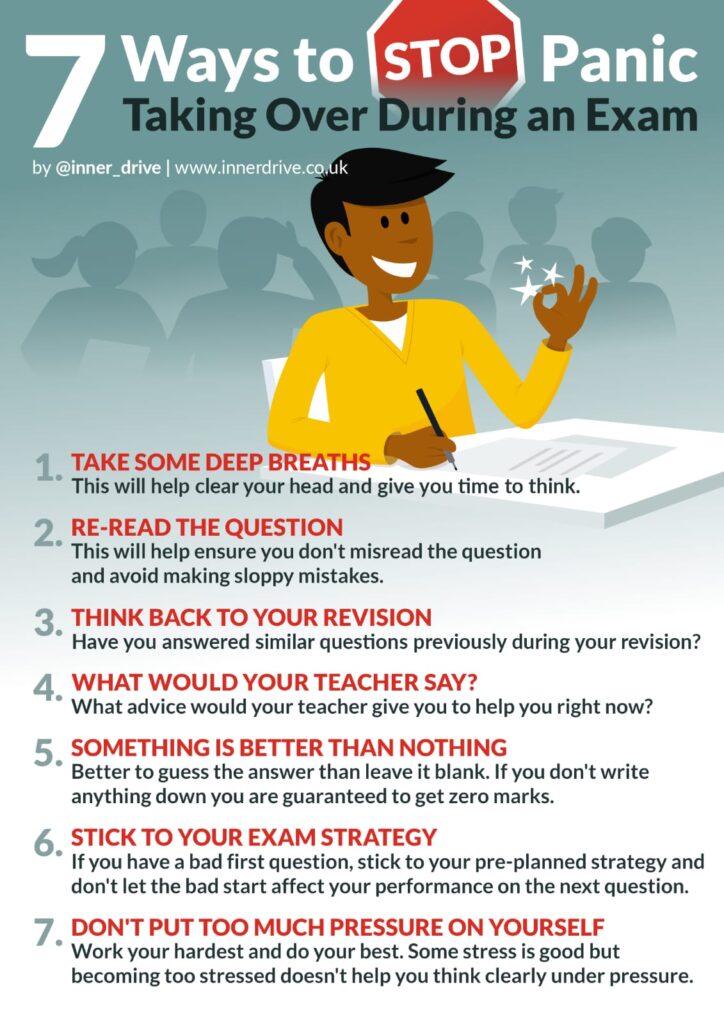Your heart’s racing. Your palms are sweating. And the exam paper is still blank. You know the material. You studied hard. But now, everything feels like it’s slipping away. This is panic. It hits fast. It freezes your thoughts. And it doesn’t care how prepared you are.
Even the best students experience it. Even those who aced their practice tests. In high-pressure moments, the brain can suddenly switch into fight-or-flight mode. That’s not a sign of weakness—it’s biology.
When panic shows up, your breathing shortens. Your chest tightens. Your brain—starved of calm—starts to shut down access to memory and logic. It’s like your mind is screaming while your body freezes. But here’s the good news: you don’t need to stay stuck in panic.
You can take back control. Quickly. This article will teach you a simple, science-backed method to reset your nervous system during exam in under 60 seconds. You’ll learn how to breathe, move, and think your way back to calm.
It won’t take hours of meditation or months of practice. Just one minute. One method. And a clear way forward—starting now.
What Panic Really Is
Panic feels like chaos. But underneath, it’s just your brain doing its job—too well. When you’re stressed, your brain activates the fight-or-flight response. It’s an ancient survival system. Meant to protect you. Meant to get you out of danger fast.
Your body floods with adrenaline. Your heart starts to pound. Breathing becomes short and shallow. Muscles tighten. Blood rushes to your limbs. Why? Because your brain thinks you’re under attack. Not by a wild animal—but by that exam paper.
To survive, your brain shifts resources. It focuses on escape, not thinking. That’s when the trouble starts. The part of your brain that helps with logic and memory—the prefrontal cortex—goes offline. That’s the part you need during exams.
It holds your ability to focus, recall answers, and make decisions. But in panic mode, that system shuts down. You can’t think clearly. You can’t remember what you studied. You feel stuck. And the more you panic, the worse it gets.
This isn’t weakness. It’s not lack of preparation. It’s not a character flaw. It’s neurobiology. Automatic. Powerful. But also manageable. The key is to interrupt the panic signal. To let your brain know: “I’m not in danger. I’m okay. I need to think.”
You don’t need hours of calm to do this. Just a few intentional actions can switch your brain from panic to clarity. That’s what you’ll learn next.

The 60-Second Reset during Exam: Step-by-Step
When panic strikes during an exam or any stressful moment, it feels like your mind and body are trapped. Your heart races. Your thoughts scatter. Your vision narrows. But what if you could hit a quick reset button? You can.
In just 60 seconds, you can calm yourself down and regain focus. This simple, four-step reset uses breath, vision, body, and words. Each step targets your brain and nervous system to stop panic in its tracks.
Step 1: The Breath Reset (4–6 Breaths)
What to do: Inhale slowly through your nose for 4 seconds. Exhale gently through your mouth for 6 seconds. Repeat this for four to six breaths.
Why it works: Slow, deep breaths tap into your parasympathetic nervous system. That is your body’s “rest and digest” mode. It slows your heart rate. It lowers your blood pressure. You feel more grounded. You feel safer.
When you panic, your breaths speed up. They grow shallow. This fuels the “fight or flight” response. Your heart pounds harder. Your body floods with stress chemicals. By reversing your breath pattern, you flip the switch. You move from panic to calm.
Science behind it: Lengthening your exhales stimulates the vagus nerve. The vagus nerve tells your body to relax. It lowers cortisol, the stress hormone. It also dampens adrenaline. The result is near-instant calm.
Quick cue: Breathe in 4. Breathe out 6. Repeat.
Step 2: The Visual Reset
What to do: Lift your eyes and scan the corners of the ceiling or walls. Blink slowly three times. Gently return your gaze to your paper or task. Why it works: Panic narrows your vision. Your brain locks on the threat. It cuts out everything else. This is called “tunnel vision.” You feel trapped in your fear.
Shifting your gaze breaks the pattern. It interrupts the tunnel vision. Blinking adds a moment of rest for your eyes. It also sends a “reset” signal to your brain. When you look back, your focus is fresh. You feel more in control.
Science behind it: Your visual pathways connect directly to emotion centers in the brain. A quick gaze shift activates different neural circuits. This lowers activity in the amygdala, the brain’s fear hub. You feel safer and more present.
Quick cue: Look up. Blink thrice. Look back.
Step 3: The Body Trick
What to do: Press your tongue gently to the roof of your mouth. Hold it there for 10 seconds. Relax and release.
Why it works: Physical actions can steer your emotions. Pressing your tongue engages cranial nerves. These nerves link your face and brainstem. They send calming signals to your brain.
The pressure on your tongue draws your attention inward. It creates a small anchor in your body. This anchor breaks the loop between your racing heart and anxious thoughts. You feel more grounded in your physical self.
Science behind it: This trick stimulates the trigeminal nerve. The trigeminal nerve speeds up parasympathetic signals. That lowers stress and anxiety. It taps into your body’s natural relaxation response.
Quick cue: Tongue up. Hold 10 seconds. Release.
Step 4: The Mantra
What to do: Silently or quietly say, “I am safe. I am ready. Let’s begin.” Why it works: Panic floods your mind with scattered thoughts. This chaos fuels your fear. It makes you feel helpless.
A short mantra cuts through the noise. It anchors your mind. It shifts your focus to safety and readiness. You replace “I can’t” with “I can.” You move from worry to action.
Science behind it: Mantras quiet the default mode network (DMN). The DMN drives rumination and worry. Repeating a phrase engages your prefrontal cortex. This area governs focus and emotion control. Mantras also slow your heart and soothe your nervous system.
Quick cue: “I am safe. I am ready. Let’s begin.”
Putting It All Together
First, breathe in for 4 seconds, then breathe out for 6 seconds, repeating this four to six times. Next, look up and blink slowly three times before returning your gaze. Then press your tongue gently to the roof of your mouth and hold it for 10 seconds before releasing.
Finally, silently repeat the mantra: “I am safe. I am ready. Let’s begin.” Each step takes only a few seconds, and all together, you reset in 60 seconds for exam.
Practice Makes Perfect
These resets work best when they are automatic. Practice them daily and use them when you are calm. Gradually, they become your emotional “muscle memory.” Then, at the first sign of panic, your body and mind know exactly what to do.
Try using this sequence every morning. You can do it in bed, while walking, or before you start any task. Build the habit.
Why It Works As a System
Breath addresses your physiology. Vision interrupts the fear feedback loop. The body tricks your nervous system into calm. Words ground your thinking. Together, they hit multiple systems at once. This comprehensive approach shuts down panic fast.
You don’t have time to overthink. You just reset.
Real-World Tips
Use a timer or simple mental counting to track 4-second inhales and 6-second exhales. Choose a landmark in your environment as your visual anchor. Practice the tongue press in private until it feels natural.
Personalize your mantra if you want, keeping the focus positive and ready.
Panic can feel overpowering. But you hold the power to stop it. In just one minute, you can calm your body, clear your mind, and refocus. With practice, this reset becomes second nature. Next time stress strikes, remember: calm focus is just 60 seconds away.
Real Student Stories: The 60-Second Reset in Action during Exam
Aarav’s Math Panic
Aarav, a high school student, had always struggled with math exams. During his final paper, he froze halfway through a question. His heart pounded. His mind went blank. Numbers swam on the page. He had studied hard, but in that moment, nothing came.
Then he remembered the breath reset. He closed his eyes for a moment. He inhaled for 4 seconds and exhaled for 6. He repeated this five times. His chest stopped feeling tight. His hands stopped shaking.
Then he silently repeated the mantra: “I am safe. I am ready. Let’s begin.” After just one round, his brain seemed to wake up. He could see the numbers clearly again. He finished the question, then the next. He didn’t get everything perfect—but he completed the entire paper. And he walked out feeling proud, not defeated.
Nia’s Oral Exam Nerves
Nia was preparing for an oral exam in her language class. Speaking in front of others always made her nervous. Just before her name was called, her hands began to tremble. Her voice felt tight. Quietly, she used the body trick.
She pressed her tongue gently to the roof of her mouth for 10 seconds. She focused all her attention there. She released, then repeated it once more. To her surprise, the trembling stopped. Her shoulders dropped. Her breath slowed.
When it was her turn, she walked up calmly. She spoke clearly. She even made eye contact. Her teacher later praised her poise and confidence.
Ishan’s Pre-Exam Ritual
Ishan had a packed exam schedule. Last year, he would often burn out by the second paper. This time, he decided to use the 60-second reset before every exam. Each morning and before every paper, he did the full sequence—breath, visual reset, body trick, mantra.
It became his ritual. He noticed he felt steady, even during hard questions. He recalled answers faster. His thoughts stayed organized. By the end of exam week, he was still calm and focused. He said, “It felt like I was driving the car—not being dragged by it.”
These students show one truth: one minute of resetting can change everything.

Mastering the Moment: Stay Calm, Stay in Control with 60 Second Reset during Exam
Exams can feel unpredictable. Some questions will surprise you. Some topics may seem harder than expected. You can’t control what appears on the paper. But you can control something even more powerful—your state of mind.
Panic doesn’t have to win. It may show up, but you now have tools to face it. The 60-second reset is simple, fast, and backed by science. It helps you interrupt stress, steady your body, and refocus your mind. 60 seconds reset is all it takes to shift from chaos to clarity during exam.
But like any skill, it works best when practiced. Don’t wait until exam day. Try it during mock tests. Use it while studying. Let it become second nature. That way, when the real pressure hits, your brain will know what to do.
These steps aren’t magic. They’re practical. They’re repeatable. And they work. Even one reset of 60 second can change the outcome of your exam—and how you feel walking out of the room.
So remember: the questions may not be in your control. But your reaction? That’s yours to own. Practice the reset. Trust it. Use it when it counts. You can’t control the paper—but you can control how your brain shows up for it.
FAQs on ‘From Fear to Focus: How to Manage Exam Panic in Under 60 Seconds’
What is the 60-Second Reset?
It’s a quick, science-backed technique to calm your body and mind during stressful moments—especially exams.
How long does the entire routine take?
About one minute. Each of the four steps takes 10–15 seconds.
Can I really stop panic in just 60 seconds?
Yes. With consistent practice, this reset can rapidly shift your nervous system from panic to calm.
What are the four steps of the 60-Second Reset?
The Breath Reset, Visual Reset, Body Trick, and a calming Mantra.
Why does breathing help reduce anxiety?
Slow breathing activates your parasympathetic nervous system, which lowers stress hormones and heart rate.
What’s the best way to practice this technique?
Use it during mock exams, study sessions, or even daily moments of stress so it becomes second nature.
Can I do this in a classroom without anyone noticing?
Yes. It’s designed to be subtle. Each step can be done quietly and without drawing attention.
Why look at the ceiling corners during the Visual Reset?
It helps interrupt tunnel vision caused by anxiety and resets your brain’s attention system.
How does pressing your tongue to the roof of your mouth help?
It stimulates cranial nerves that calm the body and refocus your attention inward.
What if I forget one of the steps during an exam?
Even using just one or two steps can help. Start with breath—it’s the quickest and most effective.
Can this method help with other types of performance anxiety?
Yes. It works for presentations, public speaking, interviews, and more.
Should I say the mantra out loud?
You can, but it also works when repeated silently. The key is focusing on the words.
What if I still feel nervous after doing all four steps?
Repeat the sequence once more. The effect often builds with repetition and regular use.
Is there a specific time I should use the reset during an exam?
Use it whenever you feel overwhelmed, stuck, or anxious. Early use can prevent panic from escalating.
Can younger students use the reset too?
Absolutely. It’s simple enough for students of all ages to learn and benefit from.
Is this a substitute for long-term stress management?
No. It’s a tool for in-the-moment regulation. For long-term support, combine it with healthy sleep, habits, and study techniques.
How is this different from just “taking deep breaths”?
The 60-Second Reset uses specific timing, visual shifts, physical cues, and self-talk—all working together.
Can this improve actual test performance?
Yes. By reducing anxiety, it improves focus, memory recall, and decision-making under pressure.
Is there any risk of doing this wrong?
No. The steps are safe and easy. Just follow the timing gently and don’t overthink it.
What’s the biggest benefit of using this method?
It gives you control. Even when the exam feels overwhelming, you can reclaim your calm and confidence—fast.
~Authored by Ameya Satam





